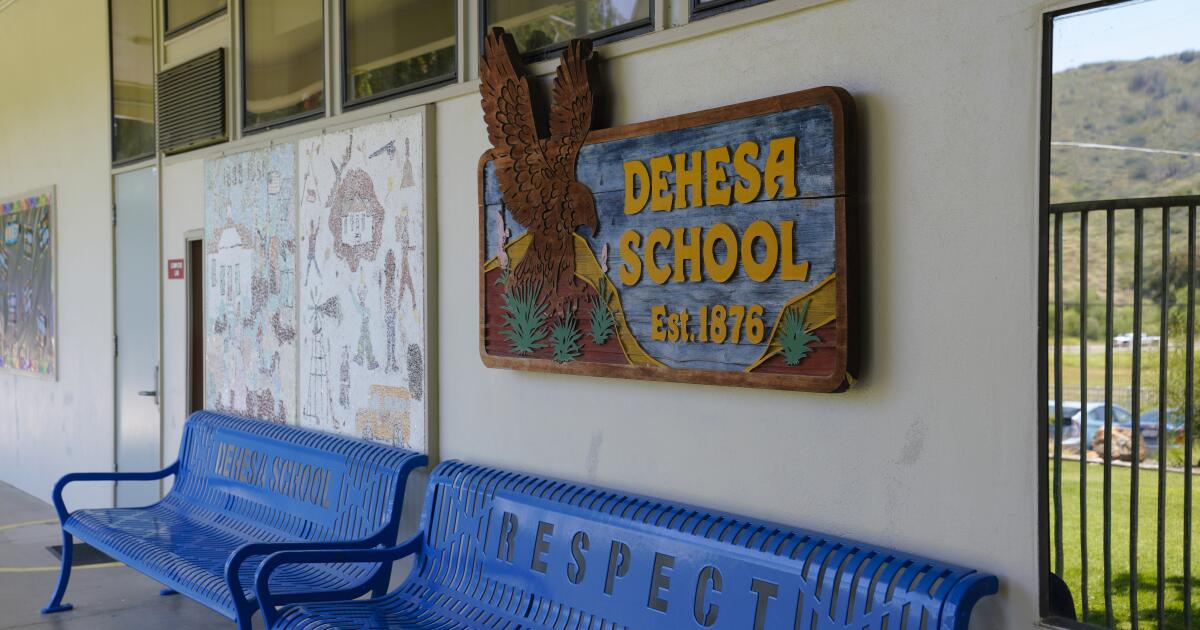
Dehesa, a single-elementary school district in the foothills of east San Diego County, made headlines in 2019 for failing to hold its charter schools accountable — in particular, three that were a key part of the statewide A3 charter scheme prosecutors said defrauded the state of $400 million.
The indictment “turned us upside down,” said Jessica Spallino, founder and CEO of Method Schools, another charter school authorized by Dehesa. “When everything crashed, it really made us feel like we have to prove that we weren’t like others.”
Within months of the indictment, Dehesa got a new superintendent, and later a new charter oversight process.
Now four years later, some school leaders say Dehesa exhibits some of the most extensive charter oversight seen in California from a small school district — to everyone’s benefit.
“It is in our best interest that that school’s process is there for everybody,” Spallino said. “When it all crashed at Dehesa, we all paid the price for that.”
‘Better authorizing makes for better schools’
Charter schools are public schools run independently of school districts. They are supposed to get more freedom and flexibility than traditional public schools in exchange for facing greater oversight; they can only be established with approval from an authorizer, most often a school district, which must then hold them accountable.
But school district and charter school leaders alike have said California’s charter oversight system is flawed and allows for authorizers to conduct little to no oversight. State law mandates few oversight duties and no consequences for authorizers who fail to perform the duties it does require. Meanwhile, some small districts have authorized several charter schools and profited off the fees they collect from the schools, which are supposed to be used for oversight.
After leaders of a statewide online charter school network called A3 were indicted in 2019, accused of defrauding the state of $400 million through their charter schools, Dehesa came under the spotlight for charter oversight gone wrong.
Dehesa was conducting little to no oversight, according to prosecutors, the judge in the A3 case and Spallino. Dehesa’s then-superintendent, Nancy Hauer, was the only person of the 11 indicted who was a superintendent of a school district that authorized A3 schools.
In 2021, a judge ordered six California school districts that authorized A3 schools, including Dehesa, to pay back $1 million of fees they had collected that were supposed to pay for oversight costs, ruling that they had failed to hold the schools accountable.
“In general — and maybe it’s partly A3 — I just think there’s more awareness that boy, authorizing’s a job that if it goes south, it could go south in a big way,” said Tom Hutton, executive director of California Charter Authorizing Professionals. “Better authorizing makes for better schools.”
After the indictment and after auditing the district’s other charter schools, Dehesa’s leaders worked to reform its oversight practices.

In the A3 indictment, Dehesa’s then-superintendent, Nancy Hauer, center, was accused of overcharging charter schools for oversight fees.
(Nelvin C. Cepeda/The San Diego Union-Tribune)
Multiple charter school leaders, including Spallino, said the greater oversight has improved their schools.
“This process has helped us to improve many policies and procedures over the years,” said Krystin Demofonte, executive director of Pacific Coast Academy, which is authorized by Dehesa, in an email. “This process has been wonderful to engage in, and we look forward to further collaboration with our authorizing district.”
Dehesa Superintendent Bradley Johnson, a former small school district business officer, took over Dehesa in 2020 and has led the district’s charter oversight reform effort. He has now been tapped to lead charter school work for the San Diego County Office of Education.
A paperwork balancing act
One of the key issues with California’s charter authorizing system, experts say, is that it often relies on small school districts like Dehesa to hold accountable. Such small districts often authorize many charter schools with far more students than those attending the district’s schools and yet lack the time and manpower needed to conduct oversight.
That’s still the case for Dehesa. This school year, it has 84 students enrolled in its own district school — it has just one — but must also oversee five charter schools that together enroll more than 10,000. As superintendent, Johnson estimates he spends a third of his time just on charter oversight.
To address this gap in manpower, Dehesa has for years contracted with an outside team of consultants who do much of the oversight work. That team was organized each year by the Small School Districts Association; as of this year, California Charter Authorizing Professionals has taken over.
Dehesa’s current oversight team is led by David Patterson, a founding board member of the statewide authorizing organization who also sits on the Placer County school board. It also includes Kathy Granger, the former superintendent of Mountain Empire Unified, another local small rural district that authorized several charter schools, as well as a certified fraud examiner who retired from the state’s education auditing agency.
Every year the oversight team compiles an oversight report hundreds of pages long that studies each charter school’s operations in six areas: governance, finance, operations, student programs and services, personnel and special education. The team finds areas in which the school may not be complying with state requirements and actions it should take to improve.
The oversight team uses an online application called Epicenter, used by other charter authorizers, to collect and organize hundreds of pages of documents from its charter schools to compile the annual reports.
“We recommend that authorizers at some level consider digitizing functions, because it’s just too much information,” Hutton said.
In the first year of Dehesa’s new oversight approach, the oversight team found many concerns with the district’s five charters. One school was reporting perfect attendance for all students. Another lacked nonprofit tax status and was collecting state funding for students attending only during the summer, even though the state does not provide funding for summer programs. And the oversight team listed several concerns with multiple other charter schools’ relationships with back-office service providers that were collecting a fixed percentage of the schools’ revenue.
There have been fewer findings of concern in recent reports. In last school year’s report, the oversight team found that some teacher authorizations were missing, identified “critically” low cash levels for one school and urged some charter schools to post agenda attachments online.
Dehesa also gives charter schools a say in the oversight process and invites their feedback at the end of the year, Johnson said.

Former A3 charter school leader, Jason Schrock, middle sits with his attorney Knut Johnson, right, and his co-defendant’s lawyer, left, at his 2021 sentencing for his part in a fraud scheme.
(Jarrod Valliere/The San Diego Union-Tribune)
Johnson, Hutton and Spallino said charter oversight is a balancing act between holding charters accountable and overwhelming them with requests.
In the immediate A3 aftermath, audit requests to Dehesa’s charters were so extensive that fulfilling them was taking staff time away from serving students, Spallino said. She said the oversight has gotten more efficient since then under Johnson’s leadership.
“I understand it was a little heavy-handed in the beginning, but I think it was appropriate at the time in order to set new processes in place,” Johnson said.
Dehesa’s increased oversight has helped Method improve its operations and transparency, Spallino said.
Now, if auditors or oversight team members ask, Method has backup documentation for its backup documentation, Spallino said. Method provides more detail on its financial reports than it used to. It has a “Transparency” page on its website that explains school leaders’ salaries, the school budget, curriculum, charter authorizations and even the school’s marketing approach and attendance reporting.
“It helps us as a charter school … that we’re on the radar, that they care about what they’re doing, they’re interested in what we’re doing,” Spallino said of Dehesa.
Covering the costs of oversight
Dehesa’s charter oversight goes beyond what the state requires.
Consulting an external panel of experts and publishing annual reports about each charter school’s performance are two of the 12 “essential practices” recommended by the National Association of Charter School Authorizers.
Most of these 12 practices are not required by state law, which prescribes few oversight duties for authorizers. According to state law, authorizers have to visit their charter schools once a year, name one staff member as a contact for charters, make sure charters submit their annual required reports, monitor schools’ financial condition and notify the state promptly if they decide to revoke a charter come renewal time.
Authorizers also must decide every five years whether to renew a charter school and allow it to keep operating. That may be the only time an authorizer is required to take a close look at its charter school’s operations.
But Johnson and Hutton say annual oversight reviews are important because they help avoid discovering major problems with a charter school come renewal time that could jeopardize its future.
“It’s in everybody’s interest to have those check-ins along the way so you don’t get to the end of five years and say, ‘Hey, your school is in trouble for re-authorization.’ That’s in nobody’s interest,” Hutton said.
Dehesa pays for its oversight consultant team entirely with the oversight fees it collects from the charter schools. The eight-member oversight team will cost Dehesa about $231,000 this school year.
State law allows authorizers to charge their charter schools up to 1 percent of their revenue to pay for actual oversight costs. Because Dehesa has several charter schools, two of which are relatively large, it is able to cover its oversight costs without charging the full 1 percent, Johnson said.
But he said 1 percent might not be enough for other small school district authorizers that have smaller or fewer charter schools. Hiring outside help might not be feasible for such districts.
“That’s part of the issue with a small district authorizing small charters. They just don’t have the revenue opportunity to get reimbursed for that work. And if that occurs, then you don’t necessarily have the manpower to do proper oversight,” Johnson said.
Johnson suggested that small school districts that lack oversight funding share resources with other small districts, such as splitting costs for oversight staff between two districts.
Hutton noted there are several resources available for authorizers, including an annual charter oversight checklist provided by the state’s education auditing agency and resources from the California School Boards Association and his own organization, California Charter Authorizing Professionals.
In addition to Dehesa, Hutton said his organization is contracted with three other school districts to help provide oversight.





